Ramón Fernandez Astudillo
Confidence-Weighted Token Set Cover for Early Hypothesis Pruning in Self-Consistency
Aug 06, 2025Abstract:Despite its simplicity and efficacy, the high token expenditure of self-consistency can limit its practical utility. Here we investigate if self-consistency can be made more token-efficient for long chain-of-thought reasoning tasks, while preserving its parallelism, through early hypothesis pruning. Concretely, we generate all solutions in parallel, but periodically prune intermediate hypotheses that are deemed unnecessary based on two lightweight indicators: (a) the model's own confidence in individual hypotheses, and (b) lexical coverage of all current hypotheses by candidate subsets that are under consideration for continued retention. We design a fast weighted set cover algorithm that utilizes the two indicators; our evaluation of five LLMs on three math benchmarks shows that this method can improve token efficiency for all models, by 10-35% in many cases.
Optimal Policy Minimum Bayesian Risk
May 22, 2025Abstract:Inference scaling can help LLMs solve complex reasoning problems through extended runtime computation. On top of targeted supervision for long chain-of-thought (long-CoT) generation, purely inference-time techniques such as best-of-N (BoN) sampling, majority voting, or more generally, minimum Bayes risk decoding (MBRD), can further improve LLM accuracy by generating multiple candidate solutions and aggregating over them. These methods typically leverage additional signals in the form of reward models and risk/similarity functions that compare generated samples, e.g., exact match in some normalized space or standard similarity metrics such as Rouge. Here we present a novel method for incorporating reward and risk/similarity signals into MBRD. Based on the concept of optimal policy in KL-controlled reinforcement learning, our framework provides a simple and well-defined mechanism for leveraging such signals, offering several advantages over traditional inference-time methods: higher robustness, improved accuracy, and well-understood asymptotic behavior. In addition, it allows for the development of a sample-efficient variant of MBRD that can adjust the number of samples to generate according to the difficulty of the problem, without relying on majority vote counts. We empirically demonstrate the advantages of our approach on math (MATH-$500$) and coding (HumanEval) tasks using recent open-source models. We also present a comprehensive analysis of its accuracy-compute trade-offs.
Latent Principle Discovery for Language Model Self-Improvement
May 22, 2025Abstract:When language model (LM) users aim to improve the quality of its generations, it is crucial to specify concrete behavioral attributes that the model should strive to reflect. However, curating such principles across many domains, even non-exhaustively, requires a labor-intensive annotation process. To automate this process, we propose eliciting these latent attributes guiding model reasoning towards human-preferred responses by explicitly modeling them in a self-correction setting. Our approach mines new principles from the LM itself and compresses the discovered elements to an interpretable set via clustering. Specifically, we employ an approximation of posterior-regularized Monte Carlo Expectation-Maximization to both identify a condensed set of the most effective latent principles and teach the LM to strategically invoke them in order to intrinsically refine its responses. We demonstrate that bootstrapping our algorithm over multiple iterations enables smaller language models (7-8B parameters) to self-improve, achieving +8-10% in AlpacaEval win-rate, an average of +0.3 on MT-Bench, and +19-23% in principle-following win-rate on IFEval. We also show that clustering the principles yields interpretable and diverse model-generated constitutions while retaining model performance. The gains our method achieves highlight the potential of automated, principle-driven post-training recipes toward continual self-improvement.
Multi-Document Grounded Multi-Turn Synthetic Dialog Generation
Sep 17, 2024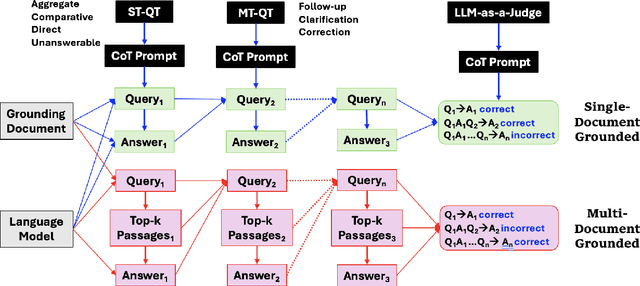


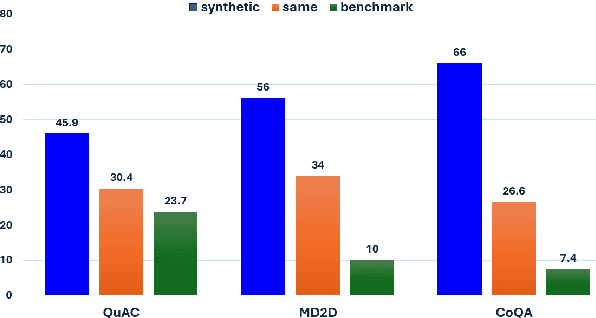
Abstract:We introduce a technique for multi-document grounded multi-turn synthetic dialog generation that incorporates three main ideas. First, we control the overall dialog flow using taxonomy-driven user queries that are generated with Chain-of-Thought (CoT) prompting. Second, we support the generation of multi-document grounded dialogs by mimicking real-world use of retrievers to update the grounding documents after every user-turn in the dialog. Third, we apply LLM-as-a-Judge to filter out queries with incorrect answers. Human evaluation of the synthetic dialog data suggests that the data is diverse, coherent, and includes mostly correct answers. Both human and automatic evaluations of answerable queries indicate that models fine-tuned on synthetic dialogs consistently out-perform those fine-tuned on existing human generated training data across four publicly available multi-turn document grounded benchmark test sets.
Self-Refinement of Language Models from External Proxy Metrics Feedback
Feb 27, 2024



Abstract:It is often desirable for Large Language Models (LLMs) to capture multiple objectives when providing a response. In document-grounded response generation, for example, agent responses are expected to be relevant to a user's query while also being grounded in a given document. In this paper, we introduce Proxy Metric-based Self-Refinement (ProMiSe), which enables an LLM to refine its own initial response along key dimensions of quality guided by external metrics feedback, yielding an overall better final response. ProMiSe leverages feedback on response quality through principle-specific proxy metrics, and iteratively refines its response one principle at a time. We apply ProMiSe to open source language models Flan-T5-XXL and Llama-2-13B-Chat, to evaluate its performance on document-grounded question answering datasets, MultiDoc2Dial and QuAC, demonstrating that self-refinement improves response quality. We further show that fine-tuning Llama-2-13B-Chat on the synthetic dialogue data generated by ProMiSe yields significant performance improvements over the zero-shot baseline as well as a supervised fine-tuned model on human annotated data.
Structured Chain-of-Thought Prompting for Few-Shot Generation of Content-Grounded QA Conversations
Feb 20, 2024
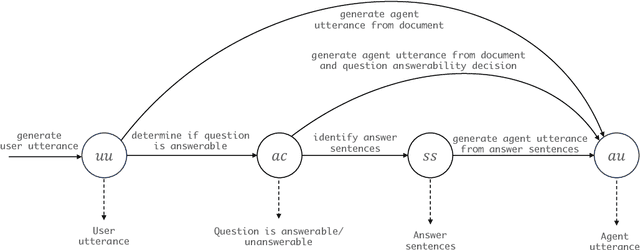

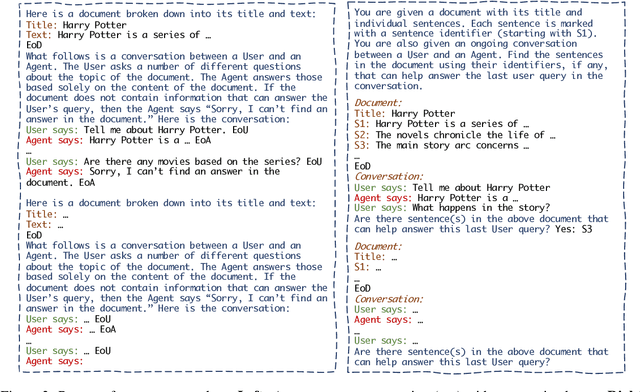
Abstract:We introduce a structured chain-of-thought (SCoT) prompting approach to generating content-grounded multi-turn question-answer conversations using a pre-trained large language model (LLM). At the core of our proposal is a structured breakdown of the complex task into a number of states in a state machine, so that actions corresponding to various subtasks, e.g., content reading and utterance generation, can be executed in their own dedicated states. Each state leverages a unique set of resources including prompts and (optionally) additional tools to augment the generation process. Our experimental results show that SCoT prompting with designated states for hallucination mitigation increases agent faithfulness to grounding documents by up to 16.8%. When used as training data, our open-domain conversations synthesized from only 6 Wikipedia-based seed demonstrations train strong conversational QA agents; in out-of-domain evaluation, for example, we observe improvements of up to 13.9% over target domain gold data when the latter is augmented with our generated examples.
BRAIn: Bayesian Reward-conditioned Amortized Inference for natural language generation from feedback
Feb 04, 2024



Abstract:Following the success of Proximal Policy Optimization (PPO) for Reinforcement Learning from Human Feedback (RLHF), new techniques such as Sequence Likelihood Calibration (SLiC) and Direct Policy Optimization (DPO) have been proposed that are offline in nature and use rewards in an indirect manner. These techniques, in particular DPO, have recently become the tools of choice for LLM alignment due to their scalability and performance. However, they leave behind important features of the PPO approach. Methods such as SLiC or RRHF make use of the Reward Model (RM) only for ranking/preference, losing fine-grained information and ignoring the parametric form of the RM (eg., Bradley-Terry, Plackett-Luce), while methods such as DPO do not use even a separate reward model. In this work, we propose a novel approach, named BRAIn, that re-introduces the RM as part of a distribution matching approach.BRAIn considers the LLM distribution conditioned on the assumption of output goodness and applies Bayes theorem to derive an intractable posterior distribution where the RM is explicitly represented. BRAIn then distills this posterior into an amortized inference network through self-normalized importance sampling, leading to a scalable offline algorithm that significantly outperforms prior art in summarization and AntropicHH tasks. BRAIn also has interesting connections to PPO and DPO for specific RM choices.
Ensemble-Instruct: Generating Instruction-Tuning Data with a Heterogeneous Mixture of LMs
Oct 21, 2023



Abstract:Using in-context learning (ICL) for data generation, techniques such as Self-Instruct (Wang et al., 2023) or the follow-up Alpaca (Taori et al., 2023) can train strong conversational agents with only a small amount of human supervision. One limitation of these approaches is that they resort to very large language models (around 175B parameters) that are also proprietary and non-public. Here we explore the application of such techniques to language models that are much smaller (around 10B--40B parameters) and have permissive licenses. We find the Self-Instruct approach to be less effective at these sizes and propose new ICL methods that draw on two main ideas: (a) Categorization and simplification of the ICL templates to make prompt learning easier for the LM, and (b) Ensembling over multiple LM outputs to help select high-quality synthetic examples. Our algorithm leverages the 175 Self-Instruct seed tasks and employs separate pipelines for instructions that require an input and instructions that do not. Empirical investigations with different LMs show that: (1) Our proposed method yields higher-quality instruction tuning data than Self-Instruct, (2) It improves performances of both vanilla and instruction-tuned LMs by significant margins, and (3) Smaller instruction-tuned LMs generate more useful outputs than their larger un-tuned counterparts. Our codebase is available at https://github.com/IBM/ensemble-instruct.
AMR Parsing with Instruction Fine-tuned Pre-trained Language Models
Apr 24, 2023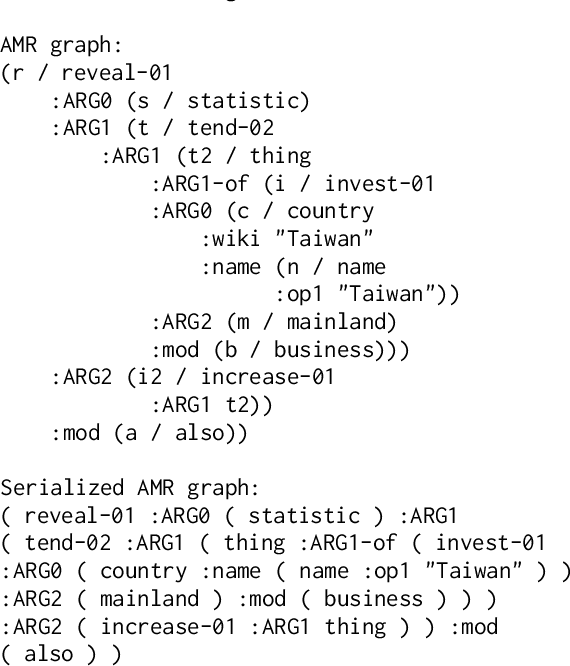

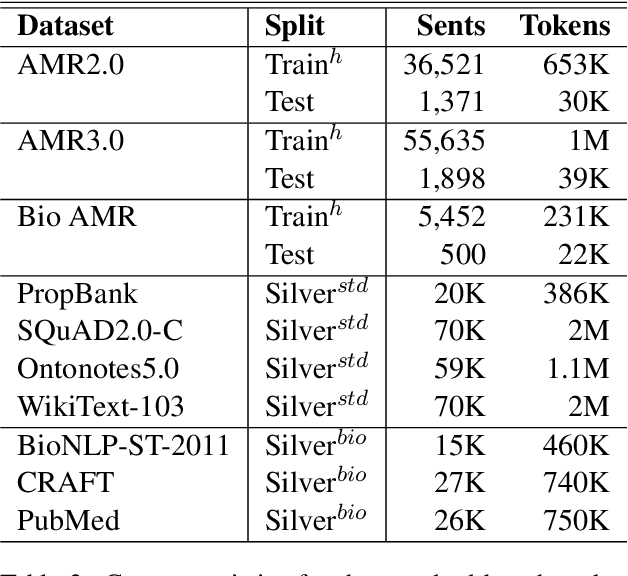

Abstract:Instruction fine-tuned language models on a collection of instruction annotated datasets (FLAN) have shown highly effective to improve model performance and generalization to unseen tasks. However, a majority of standard parsing tasks including abstract meaning representation (AMR), universal dependency (UD), semantic role labeling (SRL) has been excluded from the FLAN collections for both model training and evaluations. In this paper, we take one of such instruction fine-tuned pre-trained language models, i.e. FLAN-T5, and fine-tune them for AMR parsing. Our extensive experiments on various AMR parsing tasks including AMR2.0, AMR3.0 and BioAMR indicate that FLAN-T5 fine-tuned models out-perform previous state-of-the-art models across all tasks. In addition, full fine-tuning followed by the parameter efficient fine-tuning, LoRA, further improves the model performances, setting new state-of-the-arts in Smatch on AMR2.0 (86.4), AMR3.0 (84.9) and BioAMR (82.3).
DocAMR: Multi-Sentence AMR Representation and Evaluation
Dec 15, 2021
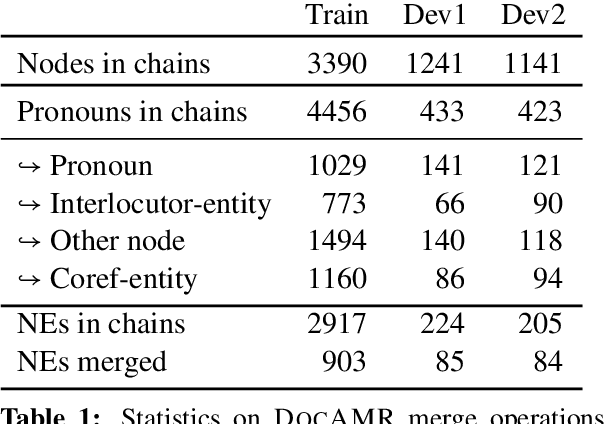

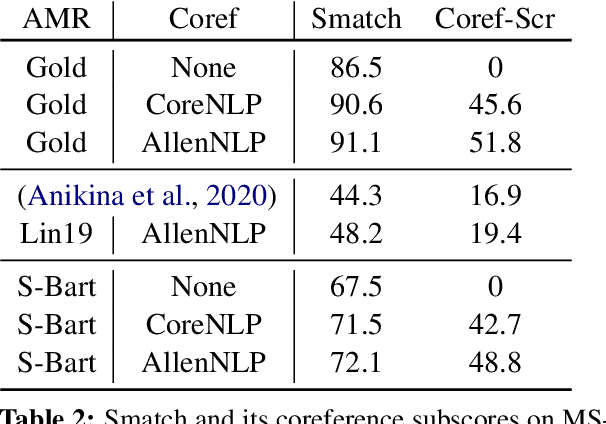
Abstract:Despite extensive research on parsing of English sentences into Abstraction Meaning Representation (AMR) graphs, which are compared to gold graphs via the Smatch metric, full-document parsing into a unified graph representation lacks well-defined representation and evaluation. Taking advantage of a super-sentential level of coreference annotation from previous work, we introduce a simple algorithm for deriving a unified graph representation, avoiding the pitfalls of information loss from over-merging and lack of coherence from under-merging. Next, we describe improvements to the Smatch metric to make it tractable for comparing document-level graphs, and use it to re-evaluate the best published document-level AMR parser. We also present a pipeline approach combining the top performing AMR parser and coreference resolution systems, providing a strong baseline for future research.
 Add to Chrome
Add to Chrome Add to Firefox
Add to Firefox Add to Edge
Add to Edge